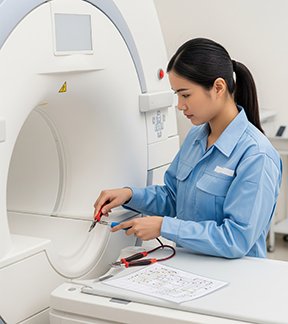Published: August 04, 2025 | Updated: October 23, 2025
Published: August 04, 2025 | Updated: October 23, 2025
A Complete Guide to Facility Management and Maintenance
 The term "facility management" frequently arises in discussions about organizational efficiency and infrastructure. This comprehensive guide unveils the core of facility management, detailing its essential components and diverse applications. This information aims to provide a clear understanding of what facility management entails and its significance in supporting organizational objectives.
The term "facility management" frequently arises in discussions about organizational efficiency and infrastructure. This comprehensive guide unveils the core of facility management, detailing its essential components and diverse applications. This information aims to provide a clear understanding of what facility management entails and its significance in supporting organizational objectives.
What is Facility Management and Why It Matters
Facility management (FM) represents a professional discipline focused on the effective provision of support services for the organizations it serves. It brings together various disciplines to ensure the functionality, comfort, safety, and efficiency of the built environment. This achievement occurs through the integration of people, place, process, and technology. Each of these elements contributes significantly to the overall success of FM operations.
The Human Element: People in FM
The human element within facility management encompasses the managers themselves, alongside the dedicated staff who uphold and operate the facilities. Operational effectiveness demands a team of proficient professionals. These individuals supervise various facets of the facility, ranging from upkeep and corrective actions to security and safety protocols. The role of people in FM includes several critical areas:
- Training and Development: Cultivating the skills and procedures among staff to competently handle their responsibilities.
- Communication: Cultivating clear and open communication channels among team members and with other vested parties.
- Leadership: Offering direction and guidance to attain established goals and objectives.
The Physical Realm: Place in FM
The physical environment, or the "place," forms the fundamental aspect of facility management. This includes buildings, infrastructure, and the surrounding areas. Managing this physical space effectively ensures the organization's operations run smoothly and safely. The role of place in FM encompasses these key functions:
Systematic Operations: Process in FM
Processes signify the systematic procedures and workflows that ensure a facility's smooth operation. Effective facility management depends on well-defined processes to manage various tasks, from routine maintenance to emergency responses. This involves:
- Standard Operating Procedures (SOPs): Developing and implementing SOPs for all aspects of facility management.
- Workflow Management: Ensuring timely and efficient task completion by workers.
- Continuous Improvement: Regularly reviewing and updating processes to heighten efficiency and effectiveness.
Continuous Improvement
Technological Advancements: Technology in FM
Technology plays a crucial part in contemporary facility management. It involves utilizing various tools and systems to enhance operations, improve effectiveness, and elevate the overall oversight of a facility. Some prominent examples of these technological applications include:
Discover how streamlined maintenance processes can elevate production. Learn more.
Integrating the Elements for Success
The true power of facility management stems from integrating these four essential elements. By aligning people, place, process, and technology, facility managers construct a unified and effective system supporting organizational goals. This integration includes:
- Collaboration: Encouraging cooperation among team members and leveraging technology to facilitate communication and information sharing.
- Informed Decision Making Through Quality Data: Using data and analytics to make informed decisions about facility operations and upkeep.
- Adaptability: Exhibiting flexibility and adjusting to changes in organizational needs and the external environment.
Facility management represents a dynamic and comprehensive discipline. Many factors contribute to its successful execution. The combination of these four aspects enables managers to create safe, comfortable, and effective spaces that uphold an organization's mission and objectives.
Diverse Facility Types Requiring Management
Many operations require diligent facility management. Here, we explore five distinct types of facilities, providing examples of each, along with the critical assets demanding consistent maintenance and preventive care.
Commercial Facilities
This category includes office buildings, retail spaces, and shopping centers. These facilities support business operations and customer interactions.
- Office Buildings: Corporate headquarters, business parks, and co-working spaces.
- Retail Stores: Standalone stores or those integrated within a larger shopping complex.
- Shopping Centers: Malls, outlet centers, and strip malls.
- Hotels: These establishments offer accommodation and various amenities for guests.
- Restaurants: Fine dining, casual dining, and fast-food establishments.
Assets Requiring Maintenance:
Industrial Facilities
Common industrial facilities include manufacturing, production, and storage. Factories, warehouses, and distribution centers also appear on this list.
- Factories: Manufacturing plants across various industries.
- Warehouses: Structures for storing goods and materials.
- Distribution Centers: Facilities handling the receipt, storage, and distribution of goods.
- Power Plants: Generate electricity.
- Refineries: Process crude oil into various products.
Assets Requiring Maintenance:
Institutional Facilities
 These facilities encompass educational institutions, healthcare facilities, and government buildings.
These facilities encompass educational institutions, healthcare facilities, and government buildings.
- Schools and Universities: Classrooms, laboratories, and administrative offices.
- Hospitals: Patient rooms, operating theaters, and diagnostic centers.
- Government Buildings: Offices, courthouses, and public service centers.
- Museums: These house and display artifacts and exhibits.
- Libraries: Store and provide access to books and other resources.
Assets Requiring Maintenance:
Discover how streamlined maintenance processes can elevate production. Learn more.
Residential Facilities
This type includes apartments, condominiums, and single-family homes.
- Apartment Buildings: High-rise and low-rise buildings.
- Condominiums: Individually owned units within a larger building.
- Single-Family Homes: Standalone residential properties.
- Retirement Communities: These provide housing and services for seniors.
- Student Housing: Accommodation for students.
Assets Requiring Maintenance:
- Plumbing Systems: Checks for leaks and maintenance of fixtures.
- Electrical Systems: Safety checks and maintenance.
- Roofing: Inspections and repairs.
- Landscaping: Maintaining gardens and outdoor spaces.
Recreational Facilities
The list of recreational facilities includes parks, sports centers, and entertainment venues.
- Parks: Public parks, playgrounds, and nature reserves.
- Sports Centers: Gyms, stadiums, and swimming pools.
- Entertainment Venues: Theaters, concert halls, and cinemas.
- Amusement Parks: These provide rides and attractions for visitors.
- Resorts: These offer a range of recreational activities and amenities.
Assets Requiring Maintenance:
- Playground Equipment: Safety inspections and maintenance.
- Sports Equipment: Regular maintenance and replacement.
- Lighting Systems: Replacing bulbs and maintaining fixtures.
- Sound Systems: Testing and maintenance.
- Landscaping: Maintaining gardens and outdoor spaces.
How CMMS Enhances Facility Maintenance Efficiency
 A Computerized Maintenance Management System (CMMS) offers significant organizational assistance for maintenance departments. As detailed previously, every type of facility possesses assets that require preventive maintenance (PM), replacement, inspections, and other repairs.
A Computerized Maintenance Management System (CMMS) offers significant organizational assistance for maintenance departments. As detailed previously, every type of facility possesses assets that require preventive maintenance (PM), replacement, inspections, and other repairs.
CMMS software contributes to the reliability of those assets. The system maintains a comprehensive list of these assets, along with all relevant information. Subsequently, you construct a list of PMs based on manufacturer recommendations, equipment readings, and historical data.
You establish priorities and cycles for each PM. In conjunction with this, the system tracks necessary spare parts and supplies through integrated inventory management.
PMs transition into work orders, providing further CMMS assistance in planning and scheduling. You assign technicians, crews, and crafts to complete each task.
Analyze various CMMS-generated reports to identify areas for operational improvement. This includes key performance indicators (KPIs), inventory reports, and work order reports. The system provides insights into on-time completion and other labor resource reports, along with depreciation values and other cost analyses.
The Broader Scope of Facility Management
While much of the discussion focused on the maintenance aspects of facility management, it clearly encompasses many more elements. Its influence extends across various sectors, ensuring the efficient operation and longevity of diversely built environments. Effective facility management contributes directly to organizational success by providing functional, safe, and comfortable spaces.
For additional information on different types of facility management, consult these sources:
FAQs
What is facility management and why is it important?
Facility management ensures the functionality, safety, comfort, and efficiency of buildings by integrating people, processes, place, and technology.
What roles do people play in effective facility management?
Staff and managers oversee maintenance, safety, and operations while fostering communication, training, and leadership to meet organizational goals.
Which types of facilities require facility management?
Commercial buildings, industrial plants, healthcare institutions, residential complexes, and recreational venues all need consistent facility management and maintenance.
How does preventive maintenance help facility management?
Preventive maintenance reduces unexpected breakdowns, extends asset life, and ensures smooth operations across all facility types.
How can CMMS software improve facility maintenance efficiency?
A CMMS like MAPCON tracks assets, schedules preventive maintenance, manages spare parts, assigns tasks, and provides reports to optimize operations.
What are the key benefits of integrating technology into facility management?
Technology enhances oversight, automates workflows, improves decision-making through data, and ensures facilities operate efficiently and safely.
MAPCON | 800-922-4336
MAPCON CMMS software empowers you to plan and execute PM tasks flawlessly, thanks to its wealth of features and customizable options. Want to see it for yourself? Click the button below to get your FREE 30-day trial of MAPCON!
Try It FREE!